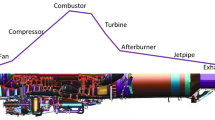Abstract
By enhancing surface properties and by reducing weight and size of machine elements, future trends in resource efficiency for machines can be fulfilled. Rolling element bearings are widely used machine elements. By improving their boundary zone properties, there is a potential to extend maintenance-free operating periods, postpone replacements or increase the lifespan of the complete system. The aim is to set favorable boundary zone properties by enhancing the residual stress state within the manufacturing process. For this, the processes hard turning and deep rolling were investigated. The influence of the initial residual stress state on fatigue life was calculated using a model based on the approach of Ioannides and Harris. The resulting residual stresses after the manufacturing process and their changes during operation in a bearing test rig are discussed and compared to those of standard bearings. The tests prove that pre-induced residual stresses increase is able to significantly delay rolling contact fatigue-related bearing failures.














Similar content being viewed by others
References
Golloch, R.: Downsizing bei Verbrennungsmotoren. Springer, Berlin (2005)
Bartz, W.J.: Reibungsminderung durch Schmierstoff und Additive (Friction Modifier). Perlach Verlag, Augsburg (1979)
Voskamp, A.: Microstructural changes during rolling contact fatigue—metal fatigue in the subsurface region of deep groove ball bearing inner rings. Thesis, Technische Universität Delft, Delft (1996)
Hacke, B., Radnai, B., Hinkelmann, K: Berücksichtigung von Betriebszuständen, Sonderereignissen und Überlasten bei der Berechnung der Wälzlager-Lebensdauer in Windenergieanlagen und Großgetrieben. Abschlussbericht FVA Forschungsheft Nr. 967, AiF-Nr. 15227 N, Frankfurt (2011)
Neubauer, T.: Betriebs- und Lebensdauerverhalten hartgedrehter und festgewalzter Zylinderrollenlager. Thesis. Leibniz Universität Hannover, Hanover (2015)
Ioannides, E., Bergling, G., Gabelli, A.: An Analytical Formulation for the Life of Rolling Bearings. Acta Polytechnica Scandinavica, Mechanical Engineering Series, vol. 137. (1999)
Denkena, B., Poll, G., Maiß, O., Pape, F., Neubauer, T.: Enhanced boundary zone rolling contact fatigue strength through hybrid machining by hard turn-rolling. Bear. World J. 1, 87–102 (2016)
Acknowledgement
The authors thank the DFG (German Research Foundation) for supporting this project in the context of the research program “Resource efficient Machine Elements (SPP1551).”
Author information
Authors and Affiliations
Corresponding author
Additional information
This article is part of the Topical Collection on STLE Tribology Frontiers Conference 2016.
Rights and permissions
About this article
Cite this article
Pape, F., Neubauer, T., Maiß, O. et al. Influence of Residual Stresses Introduced by Manufacturing Processes on Bearing Endurance Time. Tribol Lett 65, 70 (2017). https://doi.org/10.1007/s11249-017-0855-3
Received:
Accepted:
Published:
DOI: https://doi.org/10.1007/s11249-017-0855-3




